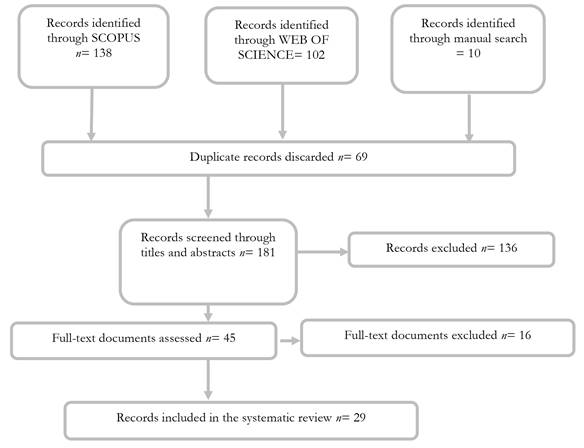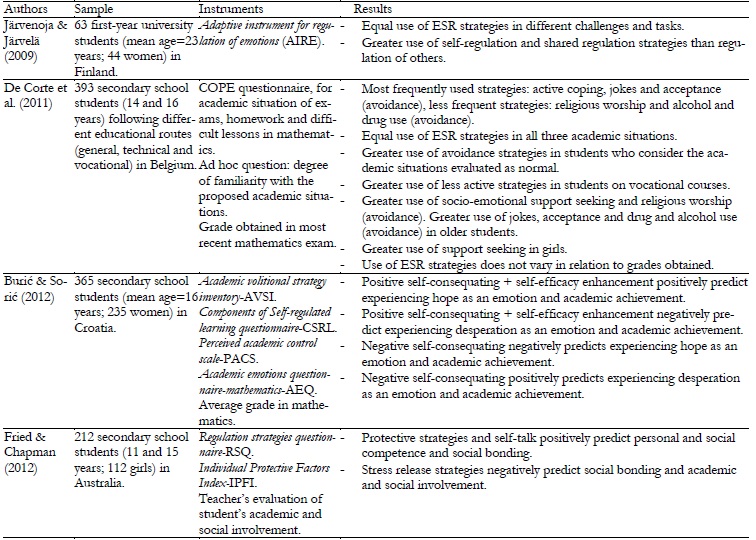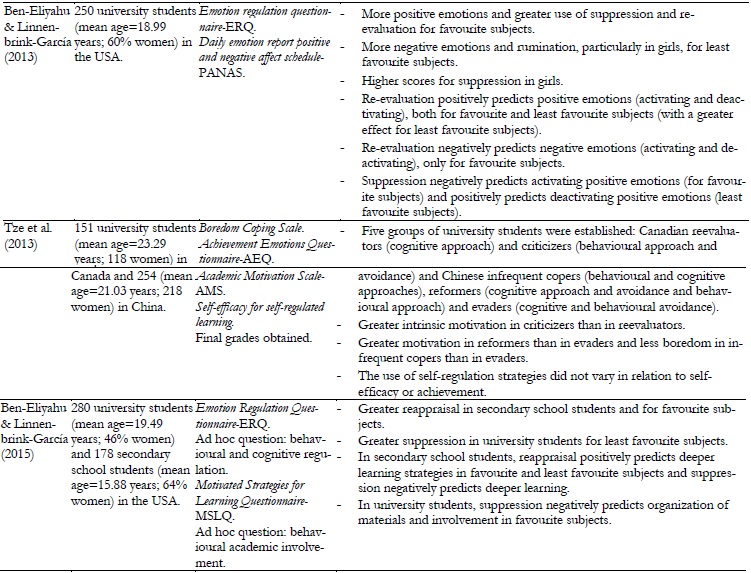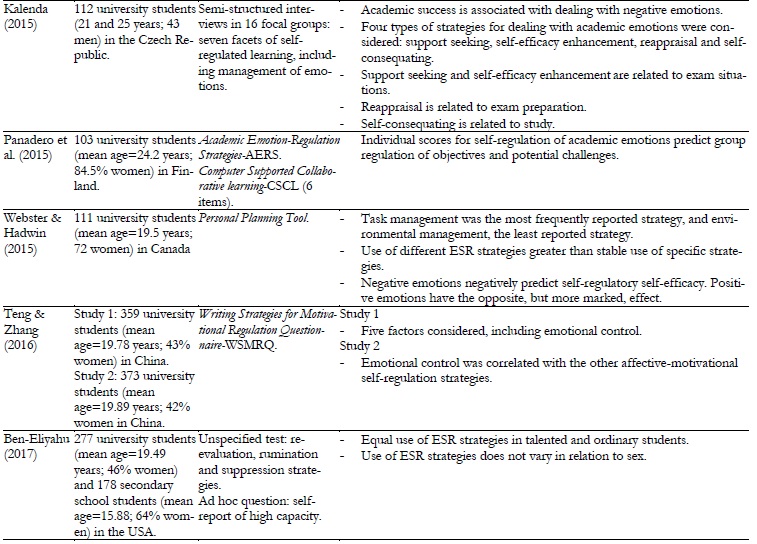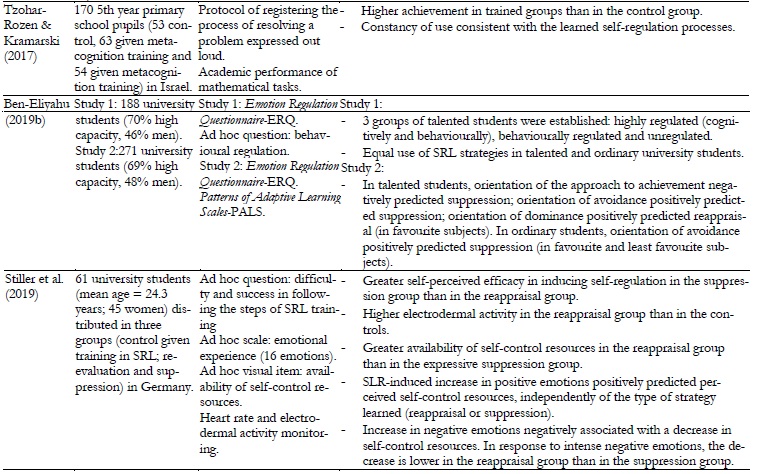Introduction
Emotions constitute an essential component of subjective well-being and psychological health (Kemeny & Shestyuk, 2008). In particular, they are considered critical factors in the teaching-learning process (Ben-Eliyahu, 2019b; Burić & Sorić, 2012; Muis et al., 2015). However, in the field of education, scarce attention was given to emotions in theoretical or empirical research until around 1980-1990 (Ben-Eliyahu, 2019b; Op't Eynde et al., 2007). Increasing numbers of researchers have gradually become interested in the impact of different emotions associated with academic activities and the way in which students manage these emotions (Pekrun & Linnenbrink-Garcia, 2014).
The effects of emotions are expected to vary depending on the nature of the emotion (Pekrun & Perry, 2014). In this respect, particular importance is given to the dimensions valence and activation (Yik et al., 2011). The former refers to the extent to which an emotion is experienced as agreeable (positive valence) or disagreeable (negative valence). On the other hand, the activation dimension of emotion determines the state of physiological excitation and distinguishes between activating and deactivating emotions. The so-called circumplex model combines both dimensions in order to establish different categories of emotions, which are assumed to have different effects on motivation, learning strategies and academic achievement (González et al., 2013; Pekrun & Linnenbrink-Garcia, 2014; Pekrun et al., 2002). Positive, activating emotions (e.g. enjoyment) generally favour concentration and motivation, as well as the use of flexible and creative learning strategies, such as organization and elaboration, all of which will lead to better execution of academic tasks. By contrast, negative, deactivating emotions (e.g. boredom) have an unfavourable effect on motivation and concentration and are associated with the use of superficial learning strategies. The effects of positive deactivating emotions (e.g. relief) and negative activating emotions (e.g. anxiety) are rather more ambiguous (Pekrun & Linnenbrink-Garcia, 2014; Pekrun et al., 2002).
The effects of emotions on learning also vary depending on the component of the learning process and on the situational conditions considered (Pekrun & Linnenbrink-Garcia, 2014). Thus, emotions associated with the academic activity itself can be distinguished from those associated with academic success/failure (Muis et al., 2015). Researchers have also begun to take an interest in epistemic emotions (related to metacognitive experiences associated with the learning process) (Muis et al., 2015). Regarding the learning conditions, we can highlight emotions generated by the social context (Boekaerts & Cascallar, 2006; Burić & Sorić, 2012) and by different subjects (Ben-Eliyahu & Linnenbrink-Garcia, 2013, 2015; Goetz et al., 2006).
As well as findings on the effects of emotions in the academic field being reported, theoretical models that clarify the role of affective dimensions in learning have also been proposed. All of these refer to the self-regulated learning (SRL) construct. SRL is defined as a process in which thoughts, feelings and actions are self-generated and systematically and deliberately aimed at achieving goals (Pintrich, 2000; Zimmerman & Schunk, 1989). More specifically, regulation of emotions is suggested to consist of becoming aware, monitoring, evaluating and modifying the occurrence, intensity and duration of particular emotional experiences that affect the learning process (Wolters, 2003). This exposes the purposeful and guided role of the learner, which determines when and how the strategic resources available for achieving personal goals should be applied in carrying out academic tasks (Panadero & Alonso-Tapia, 2004).
One of the most frequently cited models of self-regulation is the dual processing self-regulation model (Boekaerts, 2006). In this model, emotions are considered determinant factors in regard to which of two possible pathways of self-regulation will be selected in learning situations. The first pathway centres on personal well-being and the second on the learning itself. Adoption of one or other of these pathways or changing between them will depend on the appraisals and emotions generated in response to the approach and execution of academic tasks, which indicate to the students whether these are consistent with their needs and goals.
According to the control-value theory (Pekrun, 2006), appraisals associated with self-regulation and the interest or value of the task play an essential role in learning. Favourable appraisals regarding competence will be associated with positive emotions (enjoyment, hope and pride); while unfavourable appraisals will be linked to negative emotions (anger, anxiety, hopelessness and shame). On the other hand, granting an intrinsic value to a task will produce higher levels of enjoyment, while the valence of emotions associated with the extrinsic value will be variable.
The metacognitive and affective model of self-regulated learning (MASRL) (Efklides, 2011) distinguishes two levels of processing. At the macro level, the affective substrate required for carrying out the task is produced and general decisions are made for task processing. The individual acts in response to stable personal characteristics corresponding to metacognitive knowledge and emotional experiences accumulated in prior learning situations. The author of the theory proposed self-esteem and attitude towards the subject as examples of stable affective dimensions that contribute to the student's disposition towards a task. These factors may act explicitly (when the individual is conscious of them) or implicitly. Processing at the micro level occurs during specific tasks and involves prioritizing the information obtained by monitoring execution of the task. This type of processing may involve automatic processes based on task familiarity or analytical processes guided by the explicit information that the individual has about e.g. themself, the task and the context. Both of the levels of processing described interact with mutual feedback and generate emotions that are manifested during execution of the task, such as e.g. surprise due to an unexpected or discrepant event or curiosity in response to the lack of necessary information. These events will determine motivational willingness and regulation of effort. In general terms, positive affect will increase the perceived relationship between the expectation of success, effort and probable achievement. On the other hand, negative affect may interfere with the attempt to shape the task representation and must be regulated with the aim of persisting in the task execution. On completion of the task, self-reflection on the metacognitive and affective experiences, together with external feedback, will also generate emotions (such as pride or shame) and attributions that form the basis for posterior processing of other similar tasks.
By adopting a dynamic perspective, more closely focused on the affective component of self-regulated learning, Yeo et al. (2014) suggested interdependence and continuous feedback between the emotions contemplated as characteristics and emotional states. Thus, emotional characteristics will be shaped by distal processes corresponding to the macro level of processing referred to in the MASRL, while the emotional states will correspond to proximal processes analogous to the micro level of processing. In addition to providing a complementary image of the different processes involved in emotional self-regulation (ESR), this model highlights the importance of taking into account the consistency between personal affective characteristics and the transitory emotions that arise under specific academic circumstances, when predicting the effect that emotions have on academic performance; the authors also highlight the level of demand of the specific task as a contextual moderating dimension.
Finally, we will consider the recent study of Ben-Eliyahu (2019b), who details and illustrates, by means of the Academic Emotional Learning cycle (AEL), the role of emotions in the different phases of self-regulated learning differentiated by Pintrich (2004). In the forethought, planning and activation phase, the affective inclination (notion similar to the emotions as characteristics) is activated and the student can establish emotional challenges (e.g. feeling pride). In the monitoring phase, the valence and activation of the emotions experienced are recognised and their adaptation evaluated according to the student's aspirations. The control phase consists of selecting strategies for handling emotions of affective, behavioural, cognitive, somatic or motivational nature. In the fourth and final phase, reaction and reflection, the student evaluates their emotional experiences and motivations, thus contributing to shaping the affective inclination for a later learning episode.
Overall, self-regulation of emotions is of particular importance in light of the richness and complexity of the experiences and affective processes linked to academic activity and their possible effects. Emotions can potentially be regulated in a huge variety of ways, as any factor that affects emotions is theoretically a target for regulation. Determining some underlying order in these strategies therefore remains a great scientific challenge; none of the classifications proposed to date has obtained the necessary theoretical or empirical backing (Koole, 2009). However, diverse ESR strategies have been investigated. The strategies included in the documents reviewed here are included in Table 2 (results section). Research, although incipient, on these forms of ESR, the antecedents and the consequences for academic progress may provide valuable guidance for educational professionals. The present study reviewed and summarised the data and interpretations on this aspect of SRL reported in specialized journals in recent years. The specific objectives of this study were as follows: (1) to analyse the different types of ESR strategies that primary school, secondary school, technical college and/or university students use and the frequency of use of the strategies; (2) to examine the situational conditions in which these strategies are applied; (3) to explore possible dimensions of individual differences in regard to their use; and (4) to gather information on the correlates of strategies of emotional regulation used by students.
Method
A literature search of the Scopus and Web of Science databases was conducted. The search queries included the term “self regulated learning” followed by the Boolean operator AND and the alternative terms “emotions”, “emotional regulation” and “emotional control”. The search included the period between 2009 and the time when the search was carried out (November 2019).
A total of 240 items were recorded, 138 in the Scopus database and 102 in the Web of Science database; after elimination of duplicates, 171 items remained. A further 10 references, extracted after reading the documents selected (manual search), were added.
After completion of the search, the documents were examined and relevant texts were preselected on the basis of different eligibility criteria adjusted to the objectives of the review study.
The inclusion criteria were as follows: the study should involve academic emotional self-regulation; the sample should comprise primary, secondary, college and/or university students; and the language of publication should be Spanish, English, French or Portuguese. Studies focusing on the following aspects/types of sample were excluded: emotional intelligence; remote teaching methods; subjects not included in study plans (extracurricular activities) or external activities; students with metal disorders, disabilities, physical illnesses or high abilities; and students of ages that do not correspond to the study level. The documents were screened by reading the titles and abstracts and the most relevant were preselected. A total of 45 documents were read in full, with the aim of finally discarding or selecting them.
After critical reading of the preselected articles, 16 were discarded. The selection process finally identified a total of 29 documents for inclusion in the qualitative summary (15 empirical, 13 theoretical and 1 meta-analysis). The procedure used is summarised in a flow chart (Figure 1).
During the final phase, critical reading stage, the documents were examined by considering conceptual details, historical background, theoretical basis and methods, among other aspects. In addition, the data were extracted from the empirical studies considered. For this purpose, a summary table including the following criteria was constructed: author/s, sample (number of participants, age range, characteristics etc.), dimensions of interest and evaluation instruments and results (applied statistical tests and data obtained) (see Table 1). The results of a meta-analysis by Panadero et al. (2017) are included in the results section of the present review. The inputs from theoretically-based documents selected are included in the introduction and discussion sections.
Results
The results reported in the studies reviewed here are summarised in the following sections, ordered by topics related to the observed four main fields of interest: types and of frequency of use of ESR strategies; situational conditions of use; individual differences; and correlates.
Types and frequency of use of emotional self-regulation strategies
The data provided in the articles reviewed provide a tentative idea of the types of strategies that students use to manage their academic emotions (see description in Table 2). The findings of a study by Webster and Hadwin (2015) are particularly illustrative in this respect. In this study, the participants (university students) were asked to identify the emotions they experienced while carrying out academic tasks for which they had previously established personal goals. They were asked to select the emotions from a list including both agreeable (relief, hope, pride and enjoyment) and disagreeable (anger, desperation and shame) emotions and then to describe how they managed these emotions. Among the nine strategies identified, behavioural strategies were the most commonly mentioned, followed by cognitive approaches and self-consequating, while stress release and environmental management were the least frequent strategies.
Table 2: Self-regulation strategies evaluated and examples of items, statements and questions used in the studies reviewed.
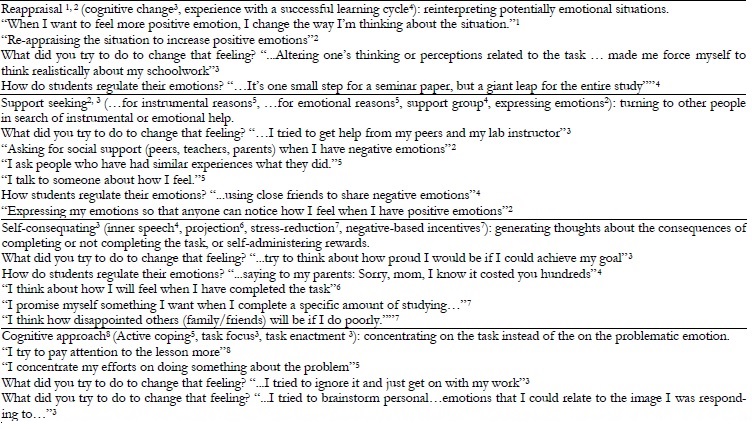
(cont.) Self-regulation strategies evaluated and examples of items, statements and questions used in the studies reviewed.

Tze et al. (2013) differentiated different groups of students attending universities in Canada and China according to their use of cognitive-approach and cognitive-avoidance strategies and behavioural-approach and behavioural-avoidance strategies, specifically in relation to dealing with boredom. In the Canadian sample, most students were categorized as reappraisers (85% of the sample), who mainly used a cognitive approach to cope with the emotion cited, in contrast to a second group of criticizers (13%), who preferentially endorsed a behavioural approach. In the Chinese sample, most of the students were classified as evaders (65%), who prioritized the use of cognitive and behavioural avoidance, while the others were classified as infrequent copers (11%) (who used cognitive and behavioural approaches) and reformers (low level of behavioural avoidance) (24%).
Situational conditions and emotional self-regulation
The use of emotional regulation strategies may vary depending on the situational conditions, as explored in some of the studies considered in the present review. More specifically, we have collected data corresponding to the following conditions: collaborative learning, favourite and least favourite subjects and academic tasks. Thus, Järvenoja and Järvelä (2009) explored the strategies used by university students in collaborative learning situations in response to different tasks and problems of a social nature. They tested the extent to which the students resorted to self-regulation, in comparison with regulation of their classmates' emotions and with mutual regulation. According to the participants, the frequency of use of these strategic approaches did not vary according to the tasks or difficulties faced; in general, the participants tended to prioritize self-regulation and mutual regulation over regulation of others.
In a later study, also involving collaborative learning in university students, Panadero et al. (2015) found that the individual scores for ESR (frequency of use of reappraisal , seeking support, negation and suppression) predicted mutual regulation of objectives and potential challenges.
Ben-Eliyahu Linnenbrink-García (2013, 2015) considered whether the ESR strategies used by secondary school and university students varied depending on the subject considered (favourite and least favourite subjects). They found that in particular reappraisal strategies may be more frequently used for favourite subjects than for least favourite subjects, while the opposite occurred with suppression and rumination.
Adopting a focus even closer to the learning process, Kalenda (2015) asked third year university students about the ESR strategies associated with different academic activities (ordinary study, exam preparation and sitting exams). According to the replies received, the students tended to manage the emotions aroused by ordinary study by self-consequating. In response to emotions experienced during exam preparation, the students preferentially used reappraisal, and in exam situations they mainly opted for support seeking and stress release.
Finally, Webster and Hadwin (2015) focused on the emotional experiences that students have to deal with; they asked the study participants (university students) to evaluate the intensity of certain emotions and to identify those which particularly interfered in the execution of academic tasks (reading, homework, study, etc.). The mean intensity was higher for positive emotions than for negative emotions, although the scores given to anxiety and boredom were very similar to those given to enjoyment (the agreeable emotion least frequently experienced). These negative emotions were recognised as a great hindrance to academic work, and a behavioural approach was preferred for coping with both. Cognitive coping strategies were predominantly used to deal with the emotions identified (e.g. desperation), followed by behavioural approach and self-consequating.
Individual dimensions and emotional self-regulation
The following different individual dimensions that may affect how students deal with academic emotions were examined: sex, age/educational level, perceived frequency of difficult academic tasks, talent and goal orientation. In regard to sex differences, in a study involving secondary school students, De Corte et al. (2011) demonstrated that girls tended to seek support more frequently than boys. The boys, by contrast, tended to suppress emotions more often than the girls, as Ben-Eliyahu and Linnenbrink-Garcia (2013) also initially observed in university students. However, in a later study, Ben-Eliyahu (2017) did not observe any sex-related differences in the use of suppression, or reappraisal and rumination. As the sample examined in the later study comprised both secondary school and university students, it is possible that the modulating effect of sex varies with age.
In fact, age/educational level appears to moderate ESR. The findings reported by De Corte et al. (2011) indicate that the students tended to apply avoidance strategies more frequently as they progressed to higher levels of secondary education, while seeking support became less frequent. However, the latter type of strategy increased again during the first year at university (Webster & Hadwin, 2015). On the other hand, secondary school students resorted to reappraisal more frequently than university students (Ben-Eliyahu & Linnenbrink-Garcia, 2015).
In the previously mentioned study involving secondary school students and mathematics, De Corte et al. (2011) analysed the ESR strategies that the students used during activities that they considered difficult (exams, homework, classes). The students who perceived these types of activities as frequent showed a greater tendency than their classmates to use avoidance and resorted significantly less often to using cognitive approaches. Interestingly, no differences were observed in relation to seeking support. The same study also showed that students who had chosen vocational training used cognitive approaches significantly less often than their classmates.
Finally, Ben-Eliyahu, (2017, 2019a) explored differences in regard to strategies of reappraisal, rumination and suppression among students previously identified as talented and their ordinary classmates and did not observe any significant differences. However, when they classified the students according to their motivational goals (directed at achievement, mastery or avoidance) they found that among the ordinary students, goal avoidance positively predicted the use of suppression. The same effect was observed in the talented students, although only for favourite subjects. For these subjects, the researchers observed a positive effect of mastery goal orientation on reappraisal and a negative effect of avoidance orientation on suppression (Ben-Eliyahu, 2019b).
Correlates of emotional self-regulation
Regarding the correlates explored in the studies reviewed, the relationships between ESR and self-evaluation of achievement, motivational self-regulation, emotions, motivation, self-efficacy and academic adjustment and performance have been investigated. We will begin by highlighting the meta-analysis carried out by Panadero et al. (2017) on the relationship between self-evaluation of performance in learning tasks and the self-regulation of negative academic emotions. The data obtained in the study, which involved primary and secondary school and university students, indicate that self-evaluation negatively predicts ESR.
In a previous study involving a sample of university students Teng and Zhang (2016) found that the use of emotional control strategies was significantly correlated with other affective-motivational self-regulation strategies (such as self-talk centred on academic goals or management of the study environment).
The association between self-regulation and emotional experiences themselves varies depending on the type of strategy considered. Reappraisal positively predicts a wide range of positive academic emotions (e.g. enjoyment and enthusiasm) and is negatively associated with negative emotions (e.g. disgust and anger), at least in university students (Ben-Eliyahu & Linnenbrink-Garcia, 2013). The opposite occurs with suppression, a strategy that negatively predicts positive emotions and positively predicts negative emotions (Ben-Eliyahu & Linnenbrink-Garcia, 2013).
In secondary school students, different effects of self-consequating have been observed depending on whether positive or negative events are anticipated. Thinking about negative consequences positively predicts desperation, while thinking about positive consequences, together with improvement in self-sufficiency, positively predicts hope (Burić & Sorić, 2012).
Data suggesting an association between ESR and academic motivation have also been reported. Specifically, in the previously described study by Tze et al. (2013), the Canadian university students characterized by using behavioural approaches and avoidance (criticizers) scored significantly higher for intrinsic motivation than re-evaluaters (who preferentially used cognitive approaches). In the sample of Chinese students included in the same study, the reformers (cognitive approach and avoidance and behavioural approach) displayed greater motivation than their classmates classified as evaders (cognitive and behavioural avoidance) or infrequent copers (cognitive and behavioural approaches).
In addition, in the study with secondary school students, Burić and Sorić (2012) , found that self-efficacy enhancement, together with positive self-consequating, predicted appraisal of control and task value, unlike what was observed in students who negative self-consequeating, which negatively predicted the aforementioned motivational dimensions.
The effects of applying ESR strategies on other facets of SRL may be particularly important. This was suggested by Ben-Eliyahu and Linnenbrink-Garcia (2015), who found that reappraisal was positively associated with the use of cognitive strategies involving elaboration and organization in secondary school students, while suppression was negatively associated with the same. Similarly, the findings reported by Stiller et al. (2019) for university students distributed in two groups (trained in reappraisal and suppression strategies) and a control group. The students trained in reappraisal strategies perceived themselves as having greater self-control resources than perceived by the group trained in suppression.
Finally, some studies have been carried out to investigate the relationship between ESR and different indicators of student adjustment. Thus, it has been shown that strategies of handling consequences and improvement of self-sufficiency positively predict personal and social competence and social links in secondary school students, while stress release strategies negatively predict social bonding and academic and social involvement (Fried & Chapman, 2012).
The relationship between ESR and academic achievement has also been explored. More specifically, positive self-consequating may have a positive effect on grades obtained in mathematics in secondary education, in contrast to when students think about negative consequences (Burić & Sorić, 2012). It has also been shown that training in emotional regulation strategies leads to improvement of achievements in mathematics in primary education (Tzohar-Rozen & Kramarski, 2017).
Discussion
The present review study aimed to obtain an idea of the most recent theoretical elaborations and data available regarding the emotional facet of SRL, an emerging, increasingly popular, field of research. The specific aims of the review were to analyse the type of strategies that students use to regulate academic emotions and to determine the personal and situational conditions that modulate the application of these strategies. The repercussions of ESR on learning were also of interest. The lack of an established integrated classification of the strategies (Koole, 2009) does not appear to have discouraged such studies; indeed, in the present review study, we have identified data on a total of eleven different types of strategies. Those that have aroused greatest interest among researchers are reappraisal and seeking support, which may be due to the connections between studies on emotional regulation and those concerning coping styles and skills (Pekrun & Stephens, 2009). However, the ESR strategies most commonly used by students, at least at university level, appear to be cognitive and behavioural approaches and self-consequating, as reappraisal and seeking support occupy an intermediate position in regard to frequency of use (Webster & Hadwin, 2015). However, the findings of the comparative study of Tze et al. (2013) indicate that the strategies that students tend to use vary between different cultures. In the absence of further research, we can assume that the diversity and frequency of use of SRL strategies will be facilitated or hampered by the action of agents of socialization, which will provide the necessary support and framework for the development of self-regulation (Ben-Eliyahu, & Bernacki).
On the other hand, in consonance with the flexible nature of SRL, the data examined indicate that the same ESR strategies are used for different ends and under different conditions and that different strategies can be used for the same aim or under the same conditions. However, how students deal with negative emotions has attracted particular attention from researchers, coinciding with the concerns of the students, who recognise that negative emotional experiences strongly interfere with learning (Webster & Hadwin, 2015) and associate emotional self-regulation with highly demanding situations that will probably generate these emotions (e.g. undertaking exams, difficult tasks) (De Corte et al., 2011; Kalenda, 2015). In these situations, the strategies most commonly used, at least by secondary school students, are cognitive approach, reappraisal and seeking support (De Corte et al., 2011; Kalenda, 2015). On the other hand, in university students, anxiety and boredom are highlighted for their intensity; both are usually dealt with by behavioural approaches (Webster & Hadwin, 2015).
The trends in strategies described may be moderated by different dimensions of individual differences. More specifically, the use of some strategies may increase with age, such as e.g. the use of avoidance strategies (De Corte et al., 2011), or they may decrease, as occurs with reappraisal (Ben-Eliyahu & Linnenbrink-Garcia, 2015) and self-consequating (Webster & Hadwin, 2015). However, seeking support becomes less common throughout secondary education (De Corte et al., 2011) but may increase again during the transition to university (Webster & Hadwin, 2015). The gradual acquisition of self-regulation skills throughout individual development and educational transitions that individuals face (e.g. incorporation into secondary education and university) may both account for the variations in use of the different types of strategies.
Differences between the sexes have also been observed in regard to seeking support (De Corte et al., 2011). Female students use this strategy more often than their male classmates, in accordance with the general trends observed in men and women regarding seeking support in diverse situations, which may or may not involve academic demands. These have been attributed to different types of experiences related to socialization, determined in relation to sex; in general, women are encouraged to share their feelings and confide in others regarding personal problems, while these types of behaviour are generally not considered appropriate in men (Tinajero et al., 2015).
Regarding the possible proximal antecedents of ESR strategies, according to the interpretation of Panadero et al. (2017) of the results of their own study, use of reappraisal may increase awareness of the objectives of the learning tasks and their execution. This effect will contribute, in turn, to diminishing negative academic emotions, thus decreasing the need for students to regulate this type of emotion. Given that ESR strategies are correlated with other motivational self-regulation strategies (Teng & Zhang, 2016), we can expect that some type of intervention, such as that suggested by Panadero et al. (2017), will generally be beneficial for affective-motivational self-regulation in learning situations.
We have not collected data in the present review regarding the efficacy of the different types of self-regulation of academic emotions, except for those reported by Ben-Eliyahu and Linnenbrink-Garcia (2013) in a study with university students. In the cited study, reappraisal was found to positively predict a wide range of positive emotions (both activating and deactivating) in favourite and least favourite subjects. By contrast, the silencing effect of this type of strategy on negative emotions (activating and deactivating) was only manifested in regard to favourite subjects. These results encourage a more detailed examination of the nature and diversity of emotional self-regulation strategies in general and of reappraisal in particular.
In agreement with the arguments posed by Pekrun and colleagues (Pekrun et al., 2002; Pekrun & Perry, 2014), the effects of emotions on learning vary depending on the dimensions valence and activation. The most effective type of emotional self-regulation will therefore be the one that addresses different types of emotions. The data reported by Burić and Sorić (2012) indicate, as expected, that self-regulation of hope (considered an activating positive emotion), specifically by strategies involving self-consequating and self-efficacy enhancement, will have favourable effects on the value attributed to the task, the perceived control and academic performance in secondary school students. The opposite effects will be obtained for dealing with hopelessness (a deactivating negative emotion) by using the same strategies.
Independently of the target emotion, favourable or unfavourable effects of some strategies can be expected. In this respect, judging by the data reported by Tze et al. (2013), both cognitive and behavioural approaches will favour intrinsic motivation. By contrast, releasing stress may negatively affect social competence and bonding and academic and social involvement (Fried & Chapman, 2012). Finally, the results of the reviewed studies addressing the learning process itself suggest that emotional self-regulation may affect the development/manifestation of self-regulated learning skills overall (Ben-Eliyahu & Linnenbrink-Garcia, 2015; Stiller et al., 2019). Further studies are required to clarify the processes involved in these effects. The theoretical models developed to date regarding the role of affective dimensions in learning represent a valuable source of inspiration.
Conclusions
In summary, although research on emotional self-regulation (ESR) is scarce to date, the present review study enabled us to discern the main focuses of research interest, to compile preliminary data and identify aspects that require further attention. In particular, we identified a lack of studies on the efficacy of different ESR strategies and the effects on learning. In this respect, exploring the strategies that students most frequently use is a priority research line. Other possible lines of research involve the self-regulation of positive academic emotions and the dimensions that determine individual differences relative to the use of ESR strategies in general. Finally, some of the findings indicate the need to explore ESR in collaborative learning situations, widening the focus from individual self-regulation to co-regulation and shared regulation. The heuristic value of recent ESR models will very probably drive future research on the above-mentioned aspects.
The summary provided in this paper should be considered with caution until further relevant research is conducted. The general approach used was determined by the scarce studies available. In future review studies, a finer focus may be able to be placed on some of the aspects of interest identified, and the meta-analysis of a group of studies should enable more precise estimates of the effects of different ESR strategies.













